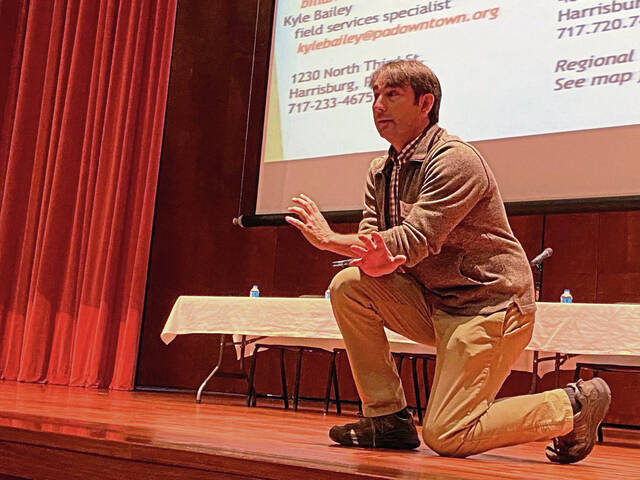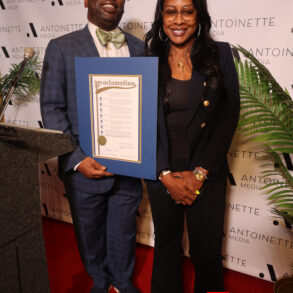
Greensburg resident Steve Gifford leased parking spaces for his apartment tenants in 2016 above the former LaRose women’s fashion shop at
124 S. Main St. in the city.
Now, thanks to a zoning ordinance change approved last week by city council, off-street parking requirements no longer will apply for those pursuing development of property in the downtown Greensburg district.
Residential development is a key component many are thinking about in the quest to revitalize the city’s downtown district, according to remarks by Gifford and other presenters and panelists at Tuesday’s Greensburg Development Conference.
“There’s a real need for residential development downtown,” said Brian Lawrence, executive director of Westmoreland County’s Redevelopment Authority and Land Bank and member of the city planning commission.
Keynote speaker Bill Arrowood, field services specialist for the nonprofit Pennsylvania Downtown Center, said having people living downtown is important for developing a city center that is vibrant at night and during the day, when Greensburg attracts people to work and to do business in the county seat.
Grow residential life
“You need to grow the residential life downtown,” Arrowood said. “You need to get people living downtown. That’s how you have a 24-hour economy, not a 9-5 economy.”
“People want to live in town if the housing stock is good, if it’s affordable.”
“That tends to be the path forward in revitalizing some of the old retail districts,” said Alec Italiano, executive director of the nonprofit Greensburg Community Development Corp. that organized the conference. “It’s keeping things going after 5 o’clock.”
More than 130 people gathered at the Seton Hill University Performing Arts Center for the second such event in the city, a follow-up to an inaugural conference held in 2019.
The conference sparked discussions about developing student housing in Greensburg.
Seton Hill University administrator Annie Urban said there is a need for more housing in Greensburg to help accommodate graduate students attending the school’s city-based campus — including about 200
who are enrolled in the Lake Erie College of Osteopathic Medicine program there.
Urban said the university also enrolls about 1,500 undergraduate students and houses 900 of them in dormitories.
Gifford said he’s had success with his AB Mac Properties company, developing four Main Street lofts above the former LaRose Shop, now occupied by the Wicks & Wax candle studio. Originally renting to all medical students, he said his tenants now are a mix of students, an auto dealership worker and a couple.
He noted the elimination of a parking requirement for downtown properties may help other developers now. Despite the need for off-street parking at the time, he said he found success with higher-end lofts featuring high ceilings that are more appealing to many university students than smaller “old school” apartments
“Some of our tenants didn’t have cars,” Gifford said “That’s why they wanted to live downtown.”
When the city’s downtown parking mandate was in place, Lawrence said, “It created a lot of challenges for developers in our community. We want to have places, not parking spaces.”
Ample space
Based on a recent local study, city officials have said there is ample parking in downtown Greensburg, although it may not be as conveniently located as some drivers would like.
Gifford operates another student housing property that falls under a city rule prohibiting development of such properties within 500 feet of each other in residential neighborhoods.
After a visit to Greensburg in the summer, a team of experts from The Counselors of Real Estate Consulting Corps “suggested relaxing those barriers to encourage more student housing,” said Jeff Raykes, city planning director. “Students are a big part of our community.”
As it is now, the 500-foot restriction doesn’t apply in Greensburg’s downtown district. “You want students to be downtown, to be close to everything they need,” Raykes said.
Jeremy Springer, a local developer with Comity Land LLC, said he had to pull back from plans for high-end apartments in Greensburg because there was no market for them. Instead, he settled on smaller-scale units.
“Three-bedroom apartments don’t need to be in downtown Greensburg,” he said.
While the Counselors of Real Estate presented possible development ideas for several major vacant downtown Greensburg buildings, a group of Seton Hill students offered their suggestions at Tuesday’s conference.
The CRE team indicated the former PNC Bank Building at 125 S. Main St. could be suited for new life as a co-working space. There, potential users including visitors to the county courthouse and local university students could share office space and services, as needed.
The Seton Hill students cited the same building among several downtown sites they proposed for co-working space or other uses. They also discussed, depending on the particular building, such additional amenities as child care, fitness and kitchen facilities.
One of the Seton Hill students, sophomore Trifol Headman, pointed to the reciprocal benefits of having students making use of facilities in downtown Greensburg. “I think that would help businesses, help the community and build relations between the students and the community,” he said.
Unique identity
Arrowood stressed the importance of establishing a unique identity for Greensburg, “finding that thing that makes your town sing. Saying you’re a great place to live, work and shop is not enough anymore.”
He said city leaders should listen to multiple voices concerning community issues, but all parties should be pulling in the same direction as they look to transform the town for the better. “Your town can become the town you want it to be,” he said. “Learn to develop your story and tell it collectively.”
Dan DeBone, president of the Westmoreland County Chamber of Commerce, said the Greensburg area has many assets that can attract developers. But, he said, “we need to be more aggressive” in promoting development and pursuing related planning, while working to stem the population loss that is expected to continue in the county.
The development conference comes as a local committee of stakeholders, led by Seton Hill, is working with a consultant to consider options for a health-and-education corridor in Greensburg. Meanwhile, another group, led by the Greensburg Community Development Corp., is seeking proposals for a consultant to craft a site plan for redeveloping a vacant lot on South Main Street where the dilapidated Advance Furniture building was razed.
“It’s really a blank canvas for a developer to come along and make the highest and best use of this property right in the heart of town,” Italiano said.
At the end of the conference, attendees were encouraged to take a self-guided tour of several dozen downtown properties that are for sale or that showcase recent or in-progress development projects.
Jeff Himler is a Tribune-Review staff writer. You can contact Jeff by email at jhimler@triblive.com or via Twitter .
This post was originally published on this site be sure to check out more of their content.








